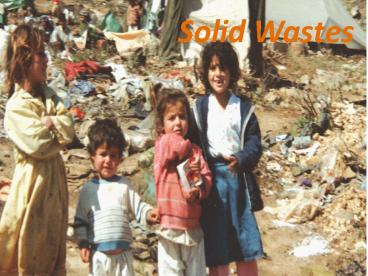Solid Wastes - PowerPoint PPT Presentation
1 / 9
Title:
Solid Wastes
Description:
Solid Wastes Any useless, unwanted discarded material that is not a liquid or gas is referred as solid waste or refuse For e.g. news paper, junk mail, today s meal ... – PowerPoint PPT presentation
Number of Views:254
Avg rating:3.0/5.0
Title: Solid Wastes
1
Solid Wastes
2
- Any useless, unwanted discarded material that is
not a liquid or gas is referred as solid waste or
refuse - For e.g. news paper, junk mail, todays meal
scraps, pieces of bread, roti, waste rice, racked
leaves, dust, grass clippings, broken furniture,
animal manure, sewage sludge, industrial refuse
or street sweepings etc.
3
- waste material is produced as a result of human
activity - Include kitchen refuse, markets and slaughter
house
4
(No Transcript)
5
(No Transcript)
6
(No Transcript)
7
CLASSIFICATION
- 1. Garbage Putrecible wastes from food,
slaughterhouses, canning and freezing industries. - 2. Rubbish non-putrecible wastes either
combustible or non-combustible. These include
wood, paper, rubber, leather and garden wastes as
comustible wastes whereas the non-combustible
wastes include glass, metal, ceramics, stones and
soil. - 3. Ashes Residues of combustion, solid products
after heating and cooking or incineration by the
municipal, industrial, hospital and apartments
areas. - 4. Large wastes Demolition and construction
wastes, automobiles, furnitures, refrigerators
and other home appliances, trees, fires etc. - 5. Dead animals House holds pets, birds,
rodents, zoo animals, and anatomical and
pathological tissues from hospitals. - 6. Sewage sludges These include screening
wastes, settled solids and sludges. - 7. Industrial wastes Chemicals, paints, sand and
explosives. - 8. Mining wastes Tailings, slug ropes, culm
piles at mine areas - 9. Agricultural wastes Farm animal manure, crop
residues and others.
8
Traditionally these wastes are categorized into
the following five types. 1. Residential It
refers to wastes generated mainly from dwelling,
apartments, and consisted of left over food
scrapes, vegetables, peeled material, plastics,
wood pieces, clothes and ashes. 2. Commercial
This mainly consists of grocery materials,
leftover food, glasses, and metals, ashes
generated from stores, hotels, markets, shops and
medical facilities. 3. Institutional The wastes
generated from schools, colleges and offices
include, paper, plastics, and glasses. 4.
Municipal This includes dust, leaf litter,
building debris, and treatment plant sediments.
These arise from various activities like
demolition, construction, street cleaning, land
scraping etc. 5. Agricultural This mainly
includes spoiled food grains, vegetables, grass,
litter etc., generated from fields and farms.
9
MISMANAGEMENT AND SIDE EFFECTS
- Insects
- Rats and other vertebrate vectors
- Fire
- Odor
- Other effects on the environment
- Atmospheric Pollution
- Visual Pollution
- Tourism/Ethics/Recreation
- Water Pollution































